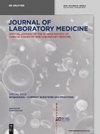Direct, age- and gender-specific reference intervals: applying a modified M-estimator of the Yeo-Johnson transformation to clinical real-world data
IF 1.8
4区 医学
Q4 MEDICAL LABORATORY TECHNOLOGY
引用次数: 0
Abstract
Objectives Reference intervals for the general clinical practice are expected to cover non-pathological values, but also reflect the underlying biological variation present in age- and gender-specific patient populations. Reference intervals can be inferred from routine patient data measured in high capacity using parametric approaches. Stratified reference distributions are obtained which may be transformed to normality via e.g. a Yeo-Johnson transformation. The estimation of the optimal transformation parameter for Yeo-Johnson through maximum likelihood can be highly influenced by the presence of outlying observations, resulting in biased reference interval estimates. Methods To reduce the influence of outlying observations on parametric reference interval estimation, a reweighted M-estimator approach for the Yeo-Johnson (YJ) transformation was utilised to achieve central normality in stratified reference populations for a variety of laboratory test results. The reweighted M-estimator for the YJ transformation offers a robust parametric approach to infer relevant reference intervals. Results The proposed method showcases robustness up to 15 % of outliers present in routine patient data, highlighting the applicability of the reweighted M-estimator in laboratory medicine. Furthermore, reference intervals are personalised based on the patients’ age and gender for a variety of analytes from routine patient data collected in a tertiary hospital, robustly reducing the dimensionality of the data for more data-driven approaches. Conclusions The method shows the advantages for estimating reference intervals directly and parametrically from routine patient data in order to provide expected reference ranges. This approach to locally inferred reference intervals allows a more nuanced comparison of patients’ test results.直接的、针对不同年龄和性别的参考区间:将杨-约翰逊转换的修正 M 估算器应用于临床实际数据
目标 一般临床实践的参考区间应涵盖非病理值,但也要反映特定年龄和性别患者群体中存在的潜在生物变异。参考区间可通过参数方法从高容量测量的常规患者数据中推断出来。分层参考分布可通过杨-约翰逊(Yeo-Johnson)变换等方法转化为正态分布。通过最大似然法估计杨-约翰逊的最佳变换参数时,可能会受到离群观测数据的严重影响,导致参考区间估计值出现偏差。方法 为了减少离群观测数据对参数参考区间估计的影响,我们采用了一种针对杨-约翰逊(YJ)转换的再加权 M-估计方法,以实现各种实验室检验结果的分层参考人群的中心正态性。YJ 转换的再加权 M 估计器为推断相关参考区间提供了一种稳健的参数方法。结果 所提出的方法对常规患者数据中 15% 的异常值具有稳健性,突出了重加权 M 估计器在检验医学中的适用性。此外,根据患者的年龄和性别,对一家三甲医院收集的常规患者数据中的各种分析物进行了参考区间个性化处理,为更多数据驱动型方法降低了数据维度。结论 该方法显示了从常规患者数据中直接估算参考区间和参数化估算参考区间以提供预期参考范围的优势。这种局部推断参考区间的方法可以对患者的检测结果进行更细致的比较。
本文章由计算机程序翻译,如有差异,请以英文原文为准。
求助全文
约1分钟内获得全文
求助全文
来源期刊

Journal of Laboratory Medicine
Mathematics-Discrete Mathematics and Combinatorics
CiteScore
2.50
自引率
0.00%
发文量
39
审稿时长
10 weeks
期刊介绍:
The Journal of Laboratory Medicine (JLM) is a bi-monthly published journal that reports on the latest developments in laboratory medicine. Particular focus is placed on the diagnostic aspects of the clinical laboratory, although technical, regulatory, and educational topics are equally covered. The Journal specializes in the publication of high-standard, competent and timely review articles on clinical, methodological and pathogenic aspects of modern laboratory diagnostics. These reviews are critically reviewed by expert reviewers and JLM’s Associate Editors who are specialists in the various subdisciplines of laboratory medicine. In addition, JLM publishes original research articles, case reports, point/counterpoint articles and letters to the editor, all of which are peer reviewed by at least two experts in the field.
 求助内容:
求助内容: 应助结果提醒方式:
应助结果提醒方式:


